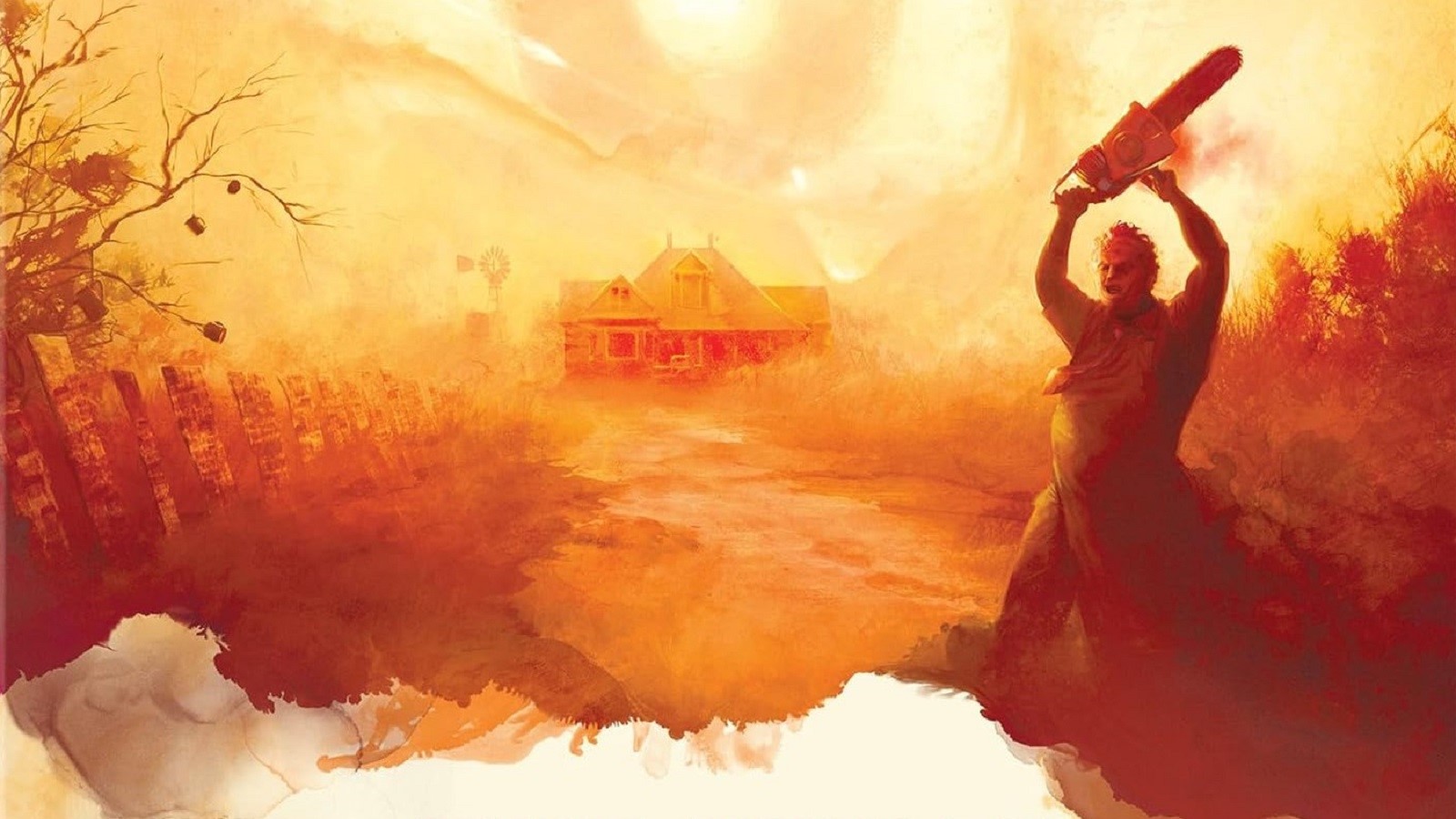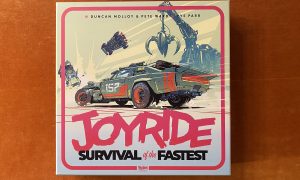Introduction – Anybody home?
The Texas Chainsaw Massacre: Slaughterhouse by Funko Games is a 2-5 player asymmetric game where each player is trying to survive an incursion into the Sawyer family home. The Trespassers each play an individual theoretically working together to accomplish an objective before the Sawyer family player can kill them off one by one. Prospero Hall has been successful in adapting various movie properties into lightweight games. Despite the gruesome theme, I think this is a good game for those looking for an easy to learn one vs. many game that is also quite a thematic horror experience. This box held a lot more than I originally expected, so let’s cut it open and see what’s inside.
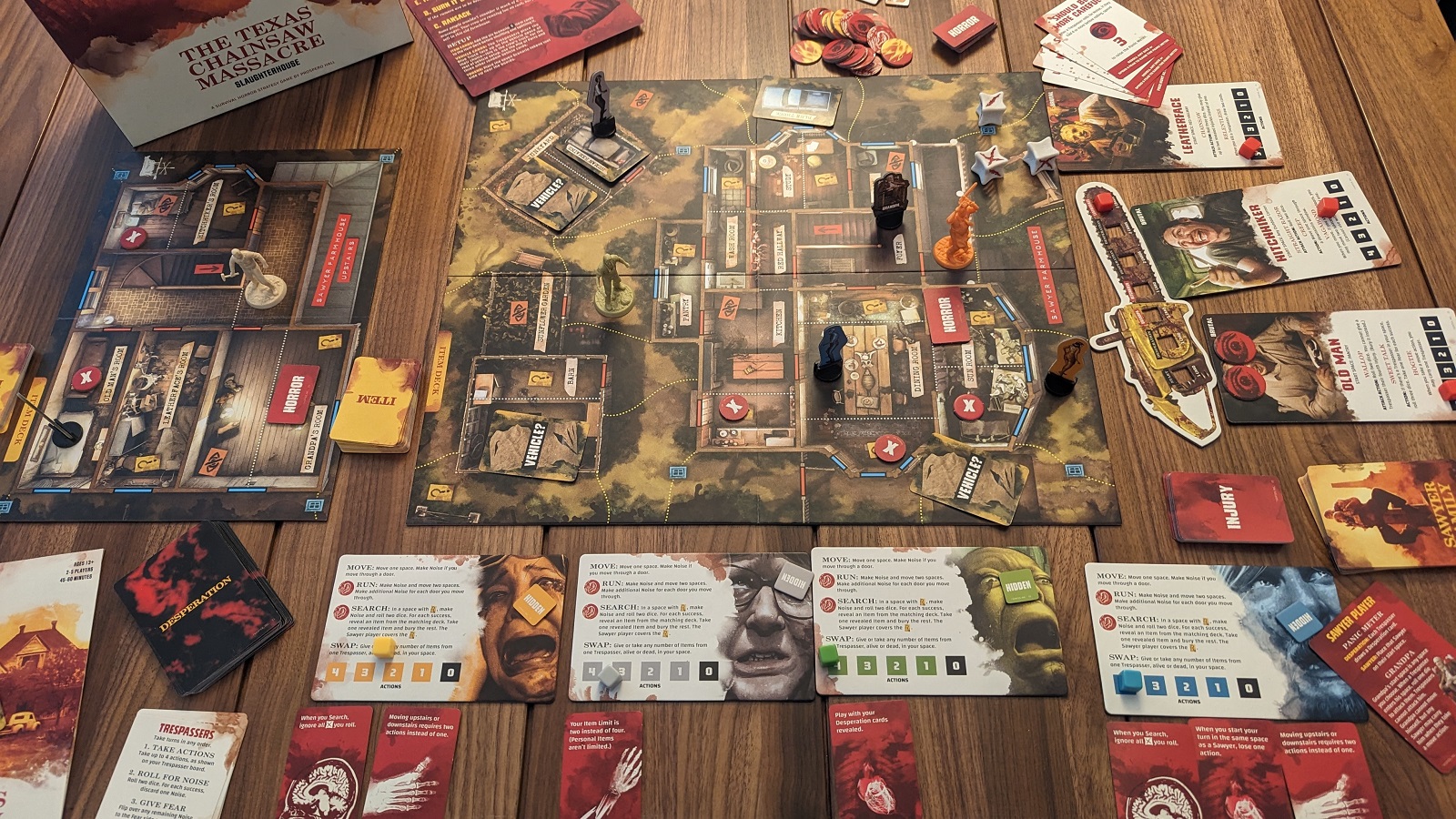
Texas Chainsaw Massacre: Slaughterhouse fully setup
Overview – We’d love to have you for dinner
The overall game is a one vs. many style board game where one player is the murderous Sawyer family trying to stop the Trespassers from completing a scenario based objective. The reason I said theoretically earlier is that the game is actually semi-cooperative. The Trespassers are trying to complete the objective and should one of them succeed they win regardless of how many other players also complete the objective. The rule book says, “there are no winners – there are only survivors,“ but it sure feels like winning when you make it out alive.
The game plays out based on an action point system. Each round, Trespassers have four actions they can do and once each Trespasser has taken their turn the Sawyer family player takes their turn by activating each member of the Sawyer family currently on the board one at a time. The Trespassers can move, run, search, swap, and take some item specific actions such as attack a Sawyer. Most actions generate a noise token which carries a risk as we will see. While there might be some decision space about how much noise you make, since the Trespassers are on a ticking clock most people I played with tried to be as quick as possible and made a lot of noise. We found that the bulk of the gameplay revolves around the Trespassers searching for items that will allow them to complete the objective while staving off the attacks from the Sawyers. At the end of each Trespasser’s turn any noise tokens they have made are handed off to the Sawyer family player as fear tokens. These tokens are used to power up the Sawyer family and increase the Panic Meter.
Meanwhile the Sawyers have similar actions allowing them to move around the board, attack Trespassers, and generate fear tokens. The Panic Meter shows how many Sawyer cards they draw at the start of their turn and the Sawyer player can draw one additional card per two fear tokens spent. These Sawyer cards can be used in one of two ways: they add additional actions to the Sawyer family or they can be used in response to certain conditions for the Trespassers. These cards are the heart of playing the Sawyer family as they make them less predictable and more dangerous. Without them, the Trespassers can figure out the limitations of the Sawyer family player and avoid most confrontations. At the start of the game the only member of the Sawyer family active is the Old Man (not to be confused with Grandpa.) As the game progresses the Panic Meter will rise, giving the Sawyer family player additional members of the family to activate. First to arrive is Grandpa, (who doesn’t actually activate) then the Hitchhiker, and last to arrive is Leatherface himself. As these characters arrive the Sawyer family becomes more dangerous and will eventually be able to hunt everyone down. Once Leatherface is on the board, everyone knows the game is nearing its end.
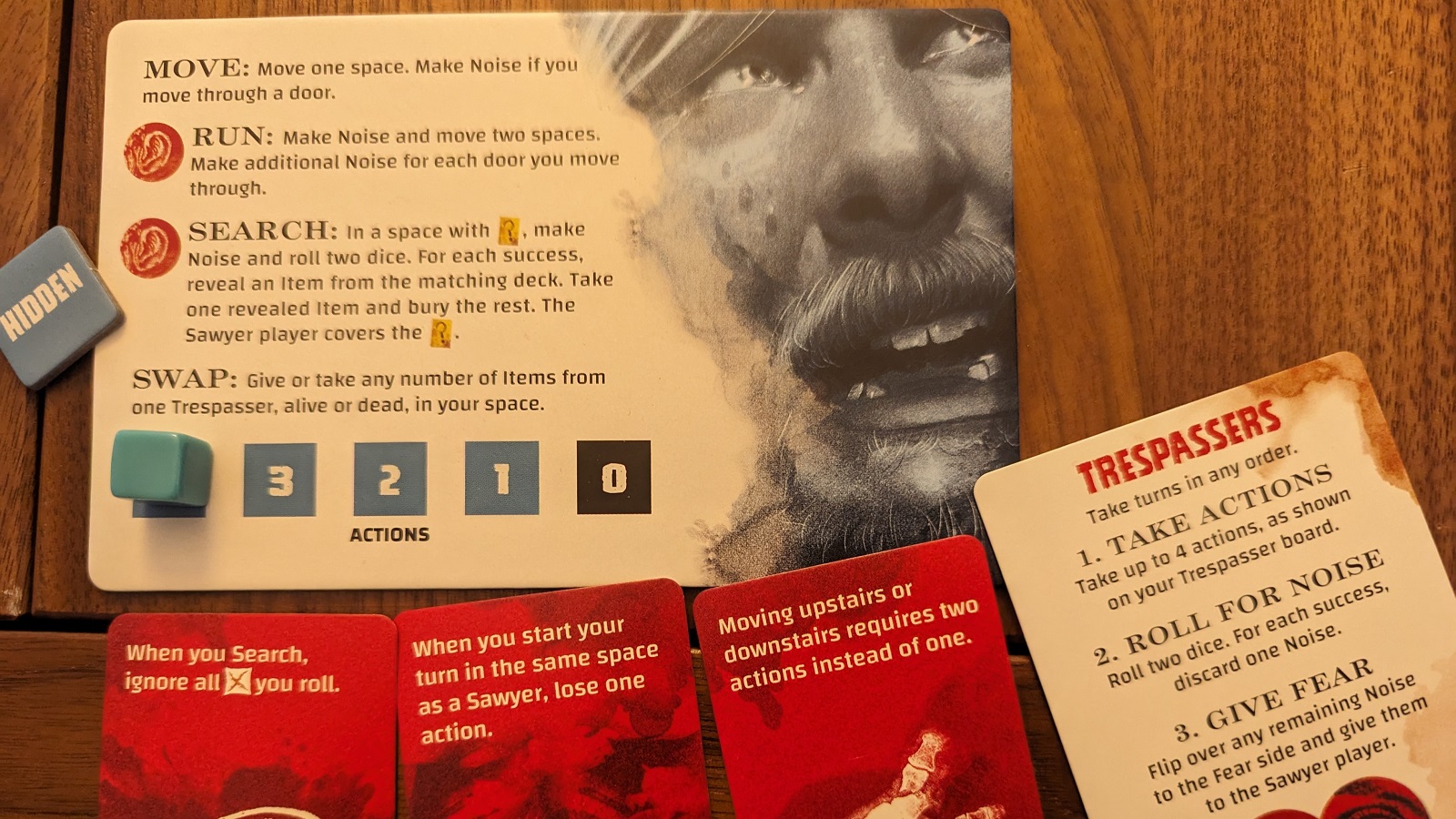
A Trespasser with three injuries
The only big “flaw” in the game’s mechanics could be the luck of the dice. The game comes with three custom “bone” (they’re plastic, but still cool) dice that drive the resolution for all actions. Whether searching for items or attacking a Trespasser, the dice determine the number of successes. It’s possible to simply roll zero successes for anything leading to disappointment. The upside is that the dice create tension and uncertainty, but when you’ve failed to search a room for the third time it’s more frustrating. As the Sawyer family player, I didn’t mind the hilarity of Leatherface repeatedly missing with his chainsaw as it allowed a narrow win for the Trespassers that game. That moment was tense and thematic where everyone was watching the outcome of the rolls. The dice also determine how much noise is converted into fear tokens and in some games the Sawyer family player was swimming in fear tokens right at the start. This caused them to be very powerful and it felt like the Trespassers never had a chance in that game. This is balanced out a little bit since the game isn’t too long and if you’ve had a poor run of luck, you can just play again, but I understand if this is a turn off for some people.
One interesting mechanic I’d like to touch on is the damage system. If this has been implemented in other games, I have not come across it yet. A Trespasser dies (and is out of the game) when they have received their fourth damage card. The big caveat is that there are four types of damage and you cannot have the same type of damage more than once. This means as you are more injured you’re harder to actually kill. Whenever an attack is successful, for each success the Sawyer player draws one damage card and then assigns one card to the Trespasser if able. I found this to be a neat innovation and sometimes Trespassers would survive several attacks since damage couldn’t be assigned to them. Other times, this didn’t protect a Trespasser at all, but if we were flipping cards for someone’s last damage, it was always dramatic.
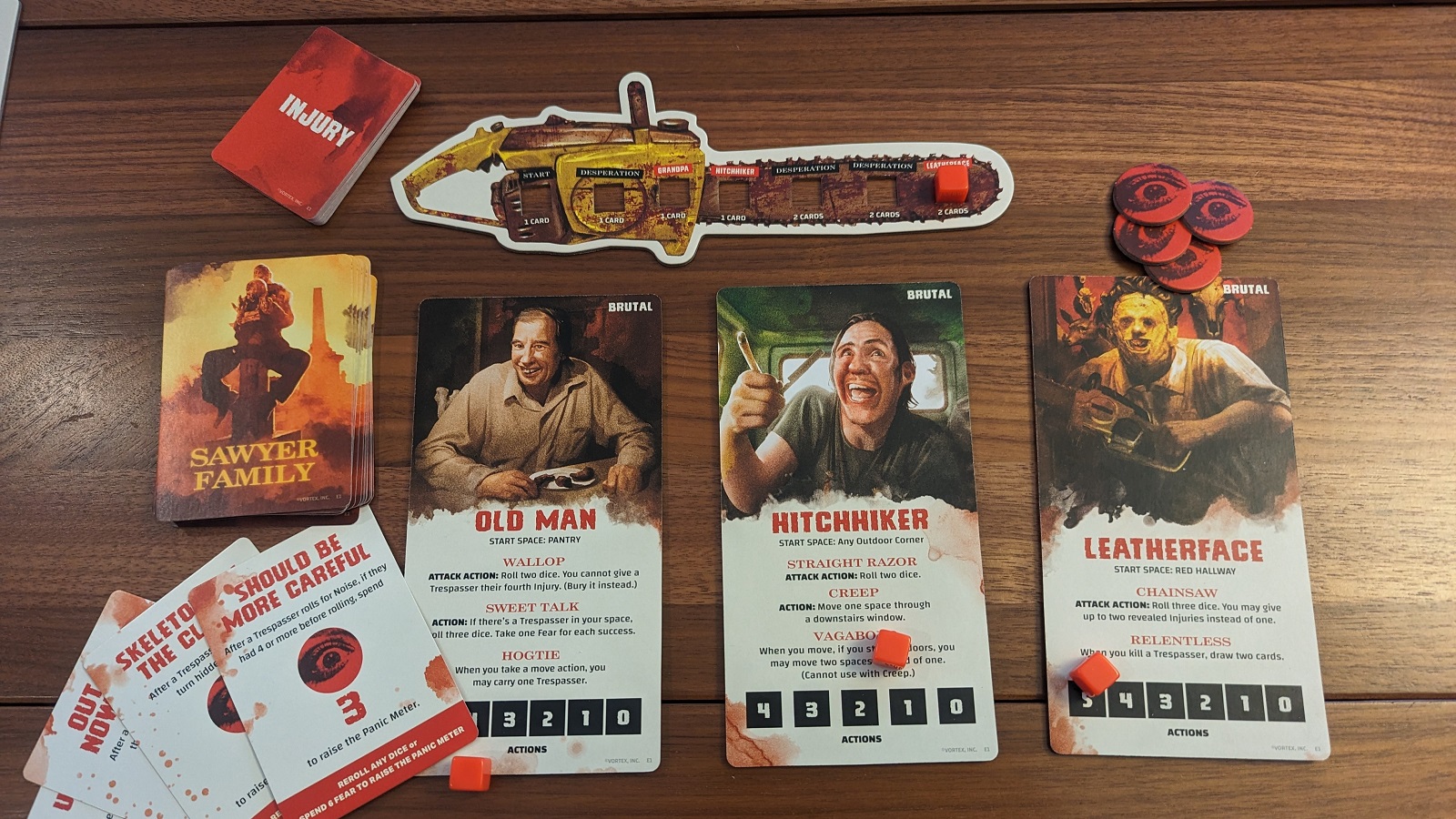
The Sawyer family player components
There are some other smaller mechanics in the game such as Desperation cards for the Trespassers. At certain points on the Panic Meter the Trespassers will get to draw one Desperation card, these are powerful one time use cards that could help a Trespassers player out of a jam. These cards seemed to be all over the place in terms of actual usefulness though. Sometimes players had exactly what they needed and other times Trespasser players couldn’t make use of them. Horror tokens are placed on the board at the start of the game. When a Trespasser enters the space with one the token is flipped up and resolved. Most of them are bad for the Trespasser players and add another small hindrance on to the pile. There are also certain spaces where Trespassers can hide making them harder to attack should a Sawyer arrive in their space. One small, but nice touch is that Trespassers start with one personal item that gives them an asymmetrical power helping to differentiate them from the rest.
There are five scenarios in the game and each one plays out slightly different. The starting scenario (Who Will Survive?) challenges the Trespassers to find a vehicle, and arrive at it with the required items to fix up the car so you can escape. Remember, this game is semi-cooperative. If you arrive at a vehicle with everything needed, you don’t have to wait for the others to escape. You can if you’re feeling generous, but on several occasions a single player escaped, effectively sealing the fate of the remaining players. I don’t know if you would find this fun, but it sure is thematic to the movies. In another game, three players watched as I dragged the fourth player back into the house with the Old Man. The three players made eye contact with the last person, before taking turns that definitely didn’t help the fourth player out of their predicament. Semi-cooperative games are rare and even harder to execute well on. While it’s completely player dependent I found this small aspect of the game worked well and was quite thematic to a horror experience.
With a price point of thirty dollars I was very impressed by the components of the game. At that price I would assume thin cardboard and marginal card quality, but inside were good quality components. The artwork might be a little monotone stylistically, but the main boards were well laid out and easy to read. Only once did anyone have any questions about the graphic design of the game and the rest of the game felt intuitive. An opening text crawl being included on the back of the main board was also a nice touch. For thirty dollars, what comes in this box is well worth that price.
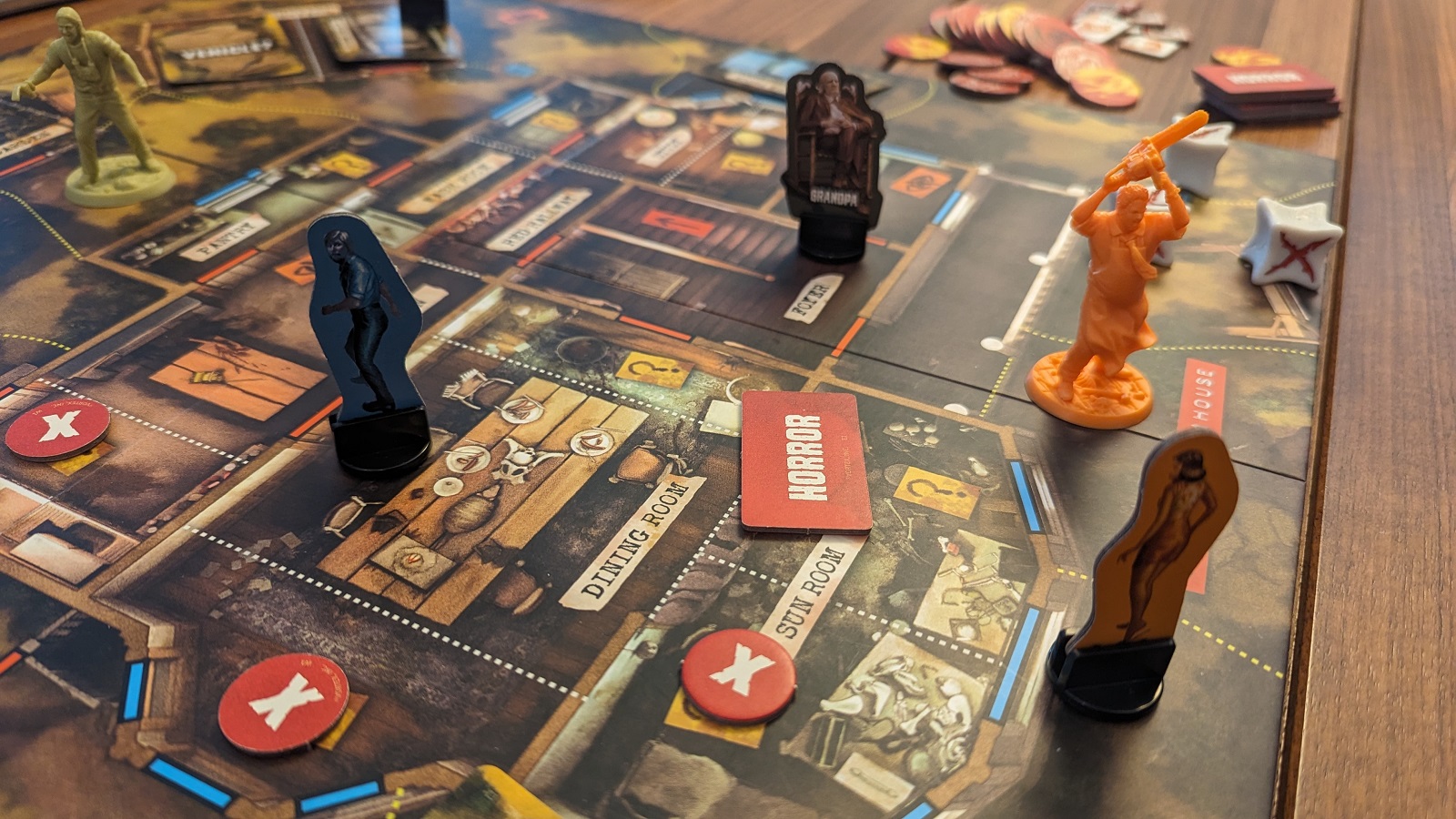
Leatherface chasing a Trespasser outside the house
The other criticisms I have for the game revolve around the turn order. Since the turn order is static (Trespassers going then Sawyers) the Trespassers can try to avoid the Sawyers if the Sawyer player doesn’t have many Sawyer cards. This game would benefit from a more dynamic turn order system where the Sawyers could activate individually instead of as a block as other games have done. One thing that became clear over repeated plays is that the game is predictable for the Sawyer player at the start. Since you only have one Sawyer active you tend to take the same actions from game to game. While not a big deal I did notice the monotony. This last one is a minor quibble, but I don’t understand putting achievement systems into board games. I understand that it is fun to unlock things, but with board games I feel it’s odd to lock content away until you’ve achieved the unlock condition. I just put all of the extra cards into the game after our first play.
Conclusion – Leaving so soon?
The Texas Chainsaw Massacre: Slaughterhouse is a fun easy to learn game. While the cadence of each game is similar the scenarios help add variety to the game. With a play time of about an hour the game never feels like it’s going on too long. Though the dice can make the game swing for one side, the drama of outcome helps take away the sting of losing should the dice not roll your way. The small bits of semi-cooperation also add to the feel of the game and you might find out who is really willing to help you out of a jam. This game excels at providing a quick horror experience and if you’re a horror fan there’s even extra fun within this box at a very reasonable price.
Chris began tabletop gaming in college and quickly fell into the addictive world of cardboard. Beginning with D&D and Catan he became an enthusiast of all things gaming; analog or digital. Chris, now a relapsed MtG player, loves connecting with people via gaming through RPGs, board games, and video games. A particular favorite is testing friendships through social deduction games.

The Texas Chainsaw Massacre: Slaughterhouse is a fun easy to learn game. While the cadence of each game is similar the scenarios help add variety to the game. With a play time of about an hour the game never feels like it’s going on too long. Though the dice can make the game swing for one side, the drama of outcome helps take away the sting of losing should the dice not roll your way. The small bits of semi-cooperation also add to the feel of the game and you might find out who is really willing to help you out of a jam. This game excels at providing a quick horror experience and if you’re a horror fan there’s even extra fun within this box at a very reasonable price.
PROS
- Semi-cooperative nature is unique
- Game is thematic
- Scenarios help increase replay value
CONS
- Game is very luck dependent
- Player turn order makes the game predictable
See below for our list of partners and affiliates:
